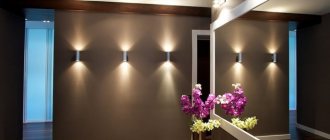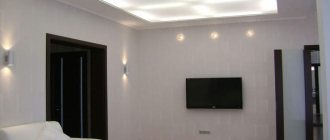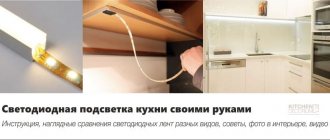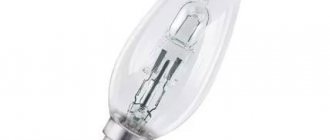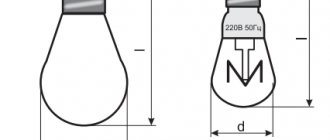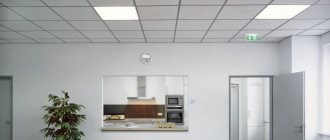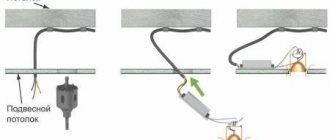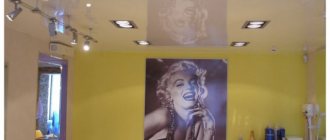Lighting plays an important role in the decor of a room. A correctly selected arrangement of lamps on a suspended ceiling or other decoration can transform a room beyond recognition; in a large hall, the space can be zoned, and a small area can be visually expanded. As an example, we will give several typical lamp placement schemes, and also present interesting design solutions for various types of premises. Since spot lighting (spots) is now popular in interior design, maximum attention is paid to it.
Choosing lighting for a stretch ceiling
When starting to design, it is important to determine the current lamp. With proper organization of lighting, the comfort of the room will increase. You need to choose based on the decorative parameters of the room and the amount of natural light.
There are 3 types of chandeliers on the market, which differ in the type of attachment to the ceiling:
- Hanging;
- Built-in;
- Ceiling-mounted.
Suspended ones are attached directly to the ceiling using a hook and a strip. The fixation is reliable, durable, fastening elements are not visible. The disadvantage of the system is that the chandelier is mounted to the bar with screws on top of the canvas. This leads to two disadvantages:
- The fabric may tear due to tension and uneven openings;
- Using incandescent or halogen lamps may cause the plastic to melt.
Hanging chandeliers are rarely used in residential premises, but are popular in cafes, restaurants, and bars. They give a large amount of light and cover huge areas.
Embedded systems are almost invisible, as they merge with the panel. A base is mounted on the ceiling in advance. After installing the ceiling, a hole is made in the fabric. A lamp with special springs is inserted into it. They straighten and tightly fix the body. Additionally, a decorative overlay is placed on top.
Visually, the light source completely merges with the surface. It looks laconic, no screws are used. Suitable for residential buildings, they allow you to zone a room. Spots are mounted in a group so that the light flux is larger. Often equipped with a fluorescent flux regulator.
The invoices got their name due to the specifics of the fastening. They are literally superimposed on the fabric. The type of fastening is similar to the previous type. They do not spoil the design of the room.
They can have a rotating (it is possible to manually adjust the direction of the light) and a non-rotating design.
Bathroom/toilet
As a rule, such functional rooms require a moderate amount of light, so it is quite possible to limit yourself to a dozen spots. There are glossy tiles on the walls and you definitely want to highlight this detail of your interior? Spotlights on the ceiling will help you with this.
When arranging spotlights in any sanitary facilities, it makes sense to adhere to strict geometry - this allows you to organize a small space.
Recommendations for lighting design
Everyone can decide for themselves where to place the lighting fixture. In this case, it is better to follow a few basic rules.
You can always add a light accent to a room to significantly improve comfort. For example, you can emphasize a work area, a play area, or a place to relax. If you like to read books, you can organize a reading area for yourself. A spotlight can autonomously change the light power in a specific area.
Additionally, you need to remember that:
- The lamps are placed at a distance of at least 30 centimeters, since a smaller gap will worsen the dispersion;
- The distance from the walls should be at least 20 cm.
- On average, a spotlight can illuminate 2 square spaces, but, depending on the power of the lamp, the indicator may float;
- With a large ceiling area, it is possible to combine different types of lamps into groups, which is useful in one-room apartments and studios.
Recessed luminaires for suspended ceilings must be LED. Their heating temperature is low. Halogen or incandescent bulbs increase temperatures and melt the fabric. This may damage the panel and the device. According to the requirements of the PUE, the control unit must be located in a place with free air exhaust to prevent overheating of the microcircuits.
Increasing/reducing space
The ability to choose the right spotlights can greatly help in correcting some of the existing shortcomings of the room. In particular, the persistent shortage of square meters and the general state of constriction in overly small rooms can be solved with the help of several lamps hidden behind the eaves. And if you add an LED strip to them, you can get an excellent lighting scenario that will allow you to forget about all the shortcomings of the room.
Lamps with G5.3 socket
On sale you can find lamps with a base of this format, both halogen and spot. Popular due to its moderate cost and ease of replacement. Previously, there were halogens that had a defect in the additional diffuser, which distributed light under the stretched film. As a result, one could see all the imperfections of the ceiling, unevenness, communications stretched under the canvas. Modern models do not have this drawback.
One of the most significant drawbacks in suspended ceilings is the deep fit inside the panel, which seems to be the main reason for poor dispersion. Since the light comes out at a right angle and the lighting is too harsh. Spots of this type are often used in children's rooms and corridors.
Device features and benefits of use
Spotlights got their name due to the small size of the lamp and the external effect of radiation from a single point.
The lamp is enclosed in a shade; hence the main feature of the spots: the light dispersion angle does not exceed 30°, and the light flux itself has the shape of a cone. A small angle allows you to illuminate a limited part of the space, so for uniform lighting, use a group of spots with a fairly dense arrangement.
The steady demand for spot lighting is explained by the following benefits of use:
- Spots are practically invisible and therefore adapt to any interior. Small ceiling lamps are hidden under the surface when installed and therefore do not burden the space.
- You can choose spots for any style. Some models allow you to adjust the direction of the light, which increases their design capabilities.
- You can evenly illuminate any room. A chandelier does not always cope with this task, but well-placed spots on the ceiling will easily solve the problem.
- You can organize partial lighting of the room, and thereby significantly save electricity.
GX53 sockets
The main difference from the previous type is the protrusion above the plane by 4-5 millimeters. For this reason, the light comes out at a maximum wide angle of 180 degrees.
The base connector has virtually no disadvantages. LED and energy-saving lamps for suspended ceilings are produced under it. Less common are halogen light bulbs and fluorescent ones.
Hallway
In a small hallway, it is enough to get by with a few spots, especially if you have a glossy stretch fabric. The light emanating from them will be quite enough, besides, the gloss perfectly reflects everything that is below, creating the necessary volume.
You can visually lengthen the hallway by sequentially placing spots on the stretch ceiling in a line.
If your hallway walls are lined with decorative stone, then do not miss the opportunity to emphasize its visual perfection with the help of accent light.
Base G9
This type is in the middle in terms of efficiency and comfort. The protrusion of the bulb is much stronger, which contributes to a powerful luminescent spread. All types of lamps are developed for this format. Suitable for industrial premises, studios, workshops, photo studios, since the beam covers the entire room.
How to choose
An important criterion when choosing lamps in the interior is their design, which is consistent with the style of the room. For a classic room, you can choose models with ornaments or crystal pendants. In a room with a modern design (modern, high-tech, loft) standard white lamps of a simple shape are suitable.
In addition to the appearance and material of the lampshade (it can be glass or acrylic), when choosing, pay attention to the following details:
- Design. If the ability to change the angle of light is important, pay attention to rotating lamps.
- Base type (usually GU10 or LED).
- Dust and moisture protection class. Important when installing in a bathroom, open veranda or kitchen.
- Possibility of changing the type of lamp (LED instead of halogen).
- Possibility of connecting a dimmer.
Review of manufacturers
There are many brands on the lighting market, whose products you can find in stores. Those who want to save money and use equipment for a long time can buy products from the following manufacturers.
Ecola. Lighting engineers emphasize the capabilities and value of this brand. The Chinese manufacturer has many positive reviews about its products. All models are equipped with a moisture protection system and are easy to install. Having top-segment qualities, they are inexpensive. Only environmentally friendly materials are used in production. The catalog contains models for any base, including table lamps. They have low heat generation, a body made of impact-resistant plastic that is not prone to temporary changes. Does not oxidize in air, does not turn black when overheated and does not emit toxic substances into the atmosphere.
Philips. A Dutch brand that focuses on practicality and minimalism. It is protected from moisture and is resistant to power surges. The Philips stretch ceiling lamp is undemanding during installation and will fit any interval between the ceiling and the film. The entire catalog has European certification and is allowed for sale by PUE and SNiP. The catalog includes flat spots and lamps with remote control. They belong to the moderately expensive segment.
Citilux. Danish manufacturer creating innovations in the lighting equipment segment. Ceiling lights for suspended ceilings "Citylux" are resistant to vibration, moisture, and mechanical damage. The products are available and have European certification. Does not require constant maintenance, easy to install. Experts are in demand for their price and environmental friendliness. Top models are equipped with flood protection. Even if there is a flood from above, there will be no short circuit inside the light bulb.
How many spots are needed and how to place them
To determine the optimal number of spotlights (if you mean main lighting), there is a special formula, but the calculation can be done in a simpler way. To do this, the following calculations are carried out:
- The total number of watts per room is determined. The area of the room is multiplied by the number of Watts required by lighting standards per 1 m2. According to SNIP, the lighting level for a bedroom is 12 W/m2, for a nursery - 15 W/m2, for a living room - 20 W/m2.
- To determine the minimum number of lamps, the total number of Watts is divided by the power of the selected lamp.
Inverse problem: to determine the power of one lamp, the total number of Watts is divided by the number of lamps.
Spotlights are installed taking into account the following conditions:
- The distance to the wall must be at least 70 cm.
- To determine the distance between lamps, the length of the wall is divided by the number of spots.
- To determine the distance of the lamps from the wall, half the length of the wall is divided by 2.
Photo examples
It is worth giving a few examples to complete the picture. Below are descriptions with photo examples showing possible solutions for the home. Among them there will be both standard schemes and original compositions.
For kitchens
The kitchen is the brightest room in the apartment. It is impossible to cook food in the twilight, so you need to provide a powerful luminous flux. It is better to zone the room: a separate place for cooking and dining. The “I” and “K” systems are common.
The second option is suitable for large areas. One line of instruments runs through the center, and additional lines of light diverge from it. This way you can flood the entire room with light.
It is important that the work area is well lit. Lamps in the kitchen can be positioned in an L shape, focusing on the cutting table. In large rooms, a chandelier is often installed above the dining area to distribute light evenly.
For the hall
The main room in the apartment should have cozy lighting, which will be pleasant to be in. The classic option is the main lighting in the form of a chandelier and auxiliary lighting. The design of suspended ceilings with spotlights and chandeliers is common due to its simplicity and efficiency. In such a room it will be pleasant to watch TV, read, communicate with family and friends.
Lamps in the living room can be placed randomly or according to your design. The uneven distribution of light allows for zoning, creating separate areas for rest and work. The scheme is common in studio apartments, where there is a lot of space.
For the bedroom
The bedroom is a place to relax. Therefore, lighting should be moderate and soft. Using classic systems of LED spotlights for suspended ceilings of type E (8 points) or H (11 points), harmonious lighting is obtained. It is advisable to supplement it with a dimmer to adjust the light. Smooth controls will allow you to adjust the mode for reading, sleeping, relaxing or watching TV.
The organization of lighting requires harmony with the interior design. The bedroom is the most furnished room, so the light will take on the palette of the overall atmosphere.
For children's room
The children's room is a multifunctional room, which is characterized by a clear zoning into a play area, a place for study and sleep. It is advisable to install powerful spots above the table that can provide the required amount of light. To avoid damaging your eyesight, you can install an additional table lamp.
A place to sleep does not need strong lighting, so a sconce will do. This element will create a warm relaxing atmosphere. It can be used as a night light or for reading before bed.
It is not advisable to install a hanging chandelier, as a child may break it while playing. The spot system will completely eliminate any need for a chandelier.
For the hallway
There is no need to install performance lighting in the corridor, so there is no need for a central chandelier. Houses and apartments with low ceilings will not allow you to turn around, which will make you feel cramped.
A convenient way to organize it would be to install spotlights along the perimeter walls. In a narrow corridor, it is better to install one line of lighting fixtures along the entire length. The small space will be well lit, and you will not feel discomfort. On multi-level ceilings it is possible to create a beautiful composition of dots.
For bathroom
In panel houses, the bathroom is small, so there are not many algorithms for lighting equipment. The classical organization of light is considered to be the “B” system. It is possible to install sconces near the mirror.
In spacious rooms you can give free rein to your imagination. For example, several lines of spots are often installed. Zoning emphasizes the breadth of the room, visually increasing its area.
Halls
Very large rooms, especially in private homes, need fairly powerful lighting. In this regard, entrusting the solution of this problem solely to spots is an extremely unwise and expensive solution. It is appropriate in such cases to use a combined option
a classic chandelier in the center, and along the perimeter, place numerous spotlights at equal distances from each other. This lighting option will create maximum comfort in the room and saturate it to the limit with air and a healthy atmosphere.
Spotlights in the interior: photo
Comments are not allowed.

